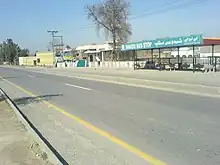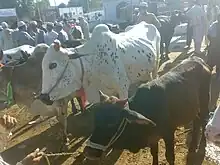Shaidu (شيدو) is a town in the Nowshera District of the Khyber Pakhtunkhwa, Pakistan. The population is approximately 75,000. Shaidu lies on the alluvial silt of the Indus River. It is a centre of the surrounding agricultural lands. Shaidu lies on the Grand Trunk Road at a strategic point. It has fallen to various ruling forces through recorded history. Shaidu is the village of Khattak tribe, and it lies on Grand Trunk Highway N-5 from Jehangira to Adamzai Village and Chashmai to Mian Essa.
Location

Shaidu township is located in the northern part of Pakistan. It lies approximately 100 km northwest of the capital Islamabad. The nearest town, Nowshera lies approximately 24 km to the west. Further away, approximately 50 km to the west is Peshawar city. Beyond Peshawar is the border with Afghanistan. To the north is the city of Mardan. To the east is the Indus River and to the south are the Khattak mountains. Shaidu lies near the south bank of the River Kabul (لندي سيند) before it joins the Indus. The Peshawar– Rawalpindi Road (N5), once the Grand Trunk Road and the railway pass through Shaidu.[1]
History
Harappan civilization

Shaidu lies within the Indus valley where men have lived since 3000 BCE.[2] Shaidu lies approximately 500 km northwest of the archeological site at Harappa, where finds indicate a flourishing Indus valley civilization lasting from 2600 BCE to 1900 BCE.[3] Theories as to the end of the Harappan civilisation include drought, invasion, epidemic illness and comet impact.[4] After the decline of the Harappan civilisation, communities became smaller and more rural.[5] However, the area of the Khyber Pakhtunkhwa became a centre for trade, culture, language and a route for eastward migration especially of the Indo-Aryan peoples.[6]
Introduction of Buddhism
The Buddhist based Kushan Empire (30 CE – 375 CE) made Purushapura (now Peshawar) one of their capitals.[7][8]
Introduction of Hinduism
As the Kushan empire fractured and declined, the Indus Valley became a suzerainty of the Gupta Empire (319 CE – 605 CE) which brought Hinduism and relative peace to the valley.[9] This peace in the northern Indus Valley, including Shaidu, was broken by an invasion of White Huns who were repelled in 455 CE.[10] One of the feudal dynasties of the Peshawar district of the 6th century and on were the Shahiya.[11]
Introduction of Islam


In 1001 CE, the Shahiya ruler, Jaipala, was defeated at the Battle of Peshawar by Mahmud of Ghazni (971 – 1030 CE).[12] Mahmud of Ghanzi, a member of the Ghaznavid dynasty, brought Islam to the region.[13]
A succession of Islamic leaders held the Indus Valley from the 1st to 8th centuries CE. Between 1173 and 1186, Muhammad of Ghor invaded and took power in Peshawar and Lahore. The population was forced to convert to Islam. His rule lasted till his assassination in 1206.[14] Following rulers included the Lodi (1451 – 1526) and the Mughal (1526 – 1857).[15] In the 17th century, local traditional tribesmen, such as the khattaks, rebelled against the foreign ruling forces.[16]
Battle of Shaidu
In the early 18th century, as the Mughal Empire declined, a new empire, the Durrani Empire was formed in the Indus valley from a union of territories.[17] However, in the late 18th century and early 19th century, a number of battles between the Durranis and Afghan Pashtun tribes ensued.[18]
Syed Ahmad (1786 – 1831) was a radical Sunni Islamist from northern India. After rallying followers, militia, funds and the credibility from two trips to Mecca, Syed Ahmad went to the Peshawar valley as Imam, intending to make the valley a base from which to destroy the Sikh Empire and defend against the British Raj.[19]
In 1827, Syed Ahmad met with the leaders of the Durranis, two brothers named Yar Muhammad Khan and Pir Muhammad Khan. The Durranis initially pled allegiance to Syed Ahmed. Legend holds that on the evening of 24 February 1827, the brothers turned and had the cook poison Syed Ahmad and the Durranis thence forth refused to fight.[19]
On 25 February 1827, Syed Ahmad's forces and the mujahidin moved towards Shaidu where the forces of the Sikh leader, Budh Singh were encamped. On the battle field, the Sikh forces prevailed but Syed Ahmad escaped. The battle field may have been at what is now the Shaidu old cemetery.[20]
British rule
By the mid 19th century, the Sikh empire was in decline. On 29 March 1849, the British East India Company militia took control of the Peshawar valley with an army of overwhelming force.[21] The British left on 14 August 1947 at Partition leaving Shaidu in the Islamic Republic of Pakistan.[22]
Geography

Shaidu's elevation above sea level is 276 m.[23] Shaidu lies on the gravel and silt alluvial plain of the Indus River with at least 300 m of rock below.[24] The area is prone to catastrophic flooding from the Indus River and earthquakes related to the movement of the Asian and Indian tectonic plates.[25][26]
Shaidu's river water source relies on meltwater from the glaciers of the Hindu Kush, Hindu Raj and Himalayas.[27] Agriculture depends on irrigation from streams as rainfall is inconsistent.[28] In the late 19th century, the British created a new irrigation system beside those of ancient days.[29]
Shaidu's climate is semi-arid to sub-humid, subtropical continental. The average annual rainfall is 550 mm per annum.[30] The Peshawar valley has summer average maximum temperatures occurring in June, rising to 40 degrees Celsius. The minimum winter average temperatures occur in January, falling to 6 degrees Celsius. Rainy days are infrequent and unpredictable, occurring one to six days per month.[31]
Agriculture
Crops
Shaidu is a centre for local farmers. Subsistence farming provides food for families. Land ownership is up to 4 acres per farmer. Crops for sale include maize, barley, wheat, corn millet, and cotton, rape seed, sugar cane, sugar beet, okra, fruits and vegetables such as tomatoes, potatoes and onions, legumes, and tobacco.[32][33] Irrigation is from canals, tube wells and rainfall. Irrigation canals may carry waste water or fresh water. The waste water carries a risk of heavy metals contamination with zinc and manganese. Water for crops is moderately saline.[33] In Charsadda, approximately 50 km from Shaidu, a crop of opium poppies was found and destroyed.[34] Acacia is grown for firewood.[35]
Gallery
Mela, Shaidu, 7 November 2011.
References
- ↑ Shaidu Google map accessed 6 February 2018
- ↑ Gupta G. India: From Indus Valley Civilization to Mauryas Concept Publishing Company, 1999 p66 ISBN 8170227631
- ↑ McIntosh J. The Ancient Indus Valley: New Perspectives ABC-CLIO, 2008 p83. ISBN 1576079074
- ↑ Phillips G. The End of Eden: the Comet that Changed Civilization Simon and Schuster, 2007 ISBN 1591439116
- ↑ Ahmed M. Ancient Pakistan - An Archaeological History Amazon, 2014 p113. ISBN 149970982X
- ↑ Bryant E. The Quest for the Origins of Vedic Culture: The Indo-Aryan Migration Debate Oxford University Press, 2003 p129. ISBN 0195169476
- ↑ Minahan J. Ethnic groups of South Asia ABC-CLIO, 2012 p258 ISBN 1598846590
- ↑ Kushan Empire Asia Society 23 June 2015. Accessed 10 February 2017.
- ↑ Ahsan A. The Indus Saga Roli Books Private Limited, 2005 ISBN 935194073X
- ↑ Ahmed M. The Arains: A Historical Perspective Createspace, 2016 p72. ISBN 1532781172
- ↑ Dikshitar R. The Gupta Polity Motilal Banarsidass 1993 p81. ISBN 8120810244
- ↑ Roy K. Military Manpower, Armies and Warfare in South Asia Routledge, 2015. ISBN 1317321278
- ↑ Spuler B. et al The Muslim World a Historical Survey Brill 1968 p61.
- ↑ Greenberger R. A Historical Atlas of Pakistan The Rosen Publishing Group, 2003 p23. ISBN 0823938662
- ↑ Ahsan A. The Indus Saga Roli Books Private Limited, 2005. ISBN 935194073X
- ↑ Later Mughal Atlantic publishers p322.
- ↑ Sikhism Pedia Press. p102
- ↑ Landsford T. Afghanistan at war ABC-CLIO, 2017 p150. ISBN 1598847600
- 1 2 Jalal A. Partisans of Allah:Jihad in South Asia Harvard University Press, 2009 p91. ISBN 0674039076
- ↑ Qadir A. Sayyid Ahmad Barailvi: His Movement and Legacy from the Pukhtun Perspective SAGE Publishing India, 2015. ISBN 9351504867
- ↑ Bhalla A. Monuments, Power and Poverty in India: From Ashoka to the Raj I.B.Tauris, 2015 p144 ISBN 1784530875
- ↑ Khan M. N. Peshawar - the Unwritten History 2004 p67.
- ↑ Shaidu Get a Map website. Accessed 20 February 2018.
- ↑ Sengor A. Tectonic Evolution of the Tethyan Region Springer Science & Business Media, 2012 p355. ISBN 9400922531
- ↑ Qadir A. Sayyid Ahmad Barailvi: His Movement and Legacy from the Pukhtun Perspective SAGE Publishing India, 2015 ISBN 9351504867
- ↑ Khan M. Earthquake-Resistant Structures: Design, Build, and Retrofit Butterworth-Heinemann, 2013 p175. ISBN 0080949444
- ↑ Hewitt K. Glaciers of the Karakoram Himalaya Springer Science & Business Media, 2013 p346. ISBN 9400763115
- ↑ Peshawar Government of Pakistan. Accessed 19 February 2018.
- ↑ Nichols R. Ethnicity, Authority and Power in Central Asia: New Games Great and Small Routledge, 2010 p154. ISBN 1136927506
- ↑ Asian Regional Maize Workshop CIMMYT p317.
- ↑ Peshawar National Oceanic and Atmospheric Administration. Accessed 20 February 2018.
- ↑ Peshawar Government of Pakistan. Accessed 21 February 2018.
- 1 2 Acton Q. Issues in Global Environment: Pollution and Waste Management Scholarly Editions, 2012 p985. ISBN 1464964874
- ↑ Pawshawar: Poppy crop destroyed in Charsadda Dawn website. 6 April 2004.
- ↑ Firewood Crops: Shrub and Tree Species for Energy Production" National Research Council (U.S.). Advisory Committee on Technology Innovation 1980.
External links
- Shaidu Maplandia.




